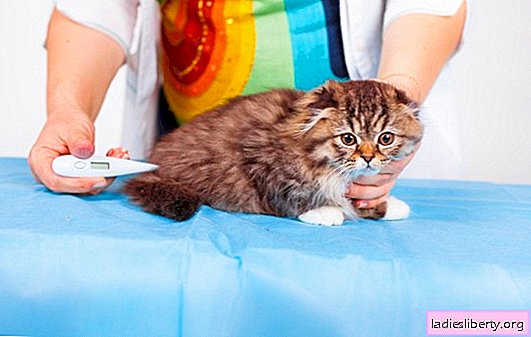
If your pet is sick, you should know how to measure the temperature of a cat and what temperature will be normal in cats. These are the very first steps to check the status of your favorite animal.
So, how to measure the temperature of a cat and what will be normal for cats?
In which cases it is worth checking the temperature of the pet
If you notice a change in the behavior and character of the pet, then you need to check his health status. There is an opinion among the people that it is possible to understand that a cat is sick by a dry and warm nose. But this is not entirely true, as this may not be related to the body temperature of the animal.
In the following situations, when one or more of the following symptoms is manifested, a decrease or increase in temperature in a cat is possible:
1) the hair and ears become obviously hot;
2) refusal of any food;
3) increased thirst, the pet can not get drunk;
4) apathy - a cat does not show interest in anything, hides from everyone;
5) the cat is suddenly afraid of people, does not come close and does not go into the arms;
6) uneven, rapid, heavy breathing and increased heart rate;
7) dilated pupils and poor coordination;
8) discharge from the nose, ears and eyes, vomiting or chills - it is urgent to find out the cause.
What is the normal temperature for cats
Normal body temperature for cats is a couple degrees above normal human temperature. The exact temperature for cats is between 38C and 38.5C.
It is important to remember that this value can vary within the normal range with age and even depending on the time of day. So in newborn kittens, the temperature can even be lower than human - about 35-36C. Weak kittens can have a low temperature, and mom cat may not pay attention to them, be sure to provide them with warmth, heating the place for them or putting a heating pad. In the first months of a kitten’s life, the temperature can also be one degree lower or higher than that of an adult cat, but this is absolutely normal.
Regarding the time of day - in the morning the temperature is half a degree lower than in the evening. Also, the temperature can fall dramatically during a pet’s deep sleep - up to 37C. Therefore, do not measure the temperature of a sleeping animal!
Even in a healthy cat, the temperature can change due to various external factors, for example, when in extreme heat, a nervous shock (moving or going to the doctor). This is a normal reaction of the body and you should not worry.
Another important note - the body temperature of hairless cats is the same as that of fluffy cats. They seem hotter to the touch compared to our skin, but there is no such difference with fluffy pets due to the fact that the wool serves as a thermal barrier.
How to measure a cat’s temperature
If you observe several symptoms of diseases, then first of all you need to measure the temperature of the cat. This usually causes difficulty, but in practice it should not become something complicated. At home, you can use a conventional thermometer (mercury thermometer), an electronic universal or rectal thermometer. The advantage of electronic thermometers is that they give a result much faster, and you will cause less inconvenience to the cat. It is advisable to buy a separate one, which will be used only for pets, and family members will use another.
The only and most reliable way is to measure the temperature rectally. It will be easier if you keep the cat together.
Follow these rules when measuring a cat’s temperature:
1) Get ready - cut the claws of the cat so that she could not accidentally injure the owners.
2) It is important to fix the animal well. There are two options - either use a towel and wrap the animal tightly in a "cocoon", be sure to hide its legs and hold its head. Or one person holds a cat with two hands - paws and head by the scruff, and the second is already taking measurements. The cat must not be allowed to curl up or tighten its tail! Be sure to monitor the position of the cat.
3) Before and after measuring the temperature, be sure to sanitize the thermometer.
4) Before you enter the thermometer, you need to lubricate it with petroleum jelly or a fat cream, so as not to injure the animal.
5) Lift the tail and enter the thermometer 2-3 cm.
6) Do not make sudden movements so as not to frighten the animal. Talk to the cat in a calm tone, calming her.
7) The mercury thermometer must be kept for about three to five minutes, the electronic one will give a signal of completion.
8) Be sure to wipe the thermometer with something alcohol-containing. Caress the animal, give your favorite treat as a reward.
Reasons for low temperature and what to do
After you have measured the temperature, you need to compare it with normal.
If the temperature is below average, the following non-infectious causes are possible:
1) First of all, it is hypothermia. If your pet has spent a large amount of time indoors / outdoors with a low temperature. At the same temperature, different animals react differently. From the breed and age of the cat will depend on how much the animal has time to freeze.
2) Anesthesia. After operations with anesthesia, the temperature of the cat may drop as well as in deep sleep.
3) Injury and shock. If your pet just got hurt or suffered severe stress, then your body temperature may temporarily drop.
4) Diseases associated with the cardiovascular system. In case of a malfunction of the heart or poor functioning of the vessels and a decrease in pressure, a constant lower temperature is also observed.
What to do when the temperature drops?
Try to warm the animal. Wrap the cat in a blanket, plaid or towel, attach a heating pad or give warm water / soup. In no case should you try to warm the animal in hot water! Sudden changes in temperature can cause heart problems!
If the temperature is too low or it is not possible to raise it within a couple of hours, as well as if there are no reasons listed above, then you should contact your nearest veterinary clinic for testing!
Causes of fever and what to do
An increase in temperature is very dangerous for cats, as it leads to a decrease in the amount of fluid in the body and impaired functioning of the internal organs. Most often, fever indicates inflammatory processes. At temperatures between 40-41C and above, immediately contact your nearest veterinary clinic!
The reasons may be the following:
1) Various infectious diseases. From the common cold to viral and fungal infections, when the body tries to fight them by increasing the temperature. Be sure to consult a doctor for tests and to identify a specific disease.
2) Poisoning. Often, in addition to disruption of the digestive system, the temperature also rises.
3) Oncological diseases. One symptom is a constant increase in temperature.
4) metabolic disorders. For example, elderly cats may have malfunctioning of the glands, which are responsible for the withdrawal of fluids and moisturizing the mucous membranes.
5) Reaction to drugs or allergens. If you gave the cat any medicine, then check for side effects of fever.
6) Inflammation of the gums, diseases of the ear or nose. Very often, inflammatory processes in the ear-throat-nose system lead to fever.











